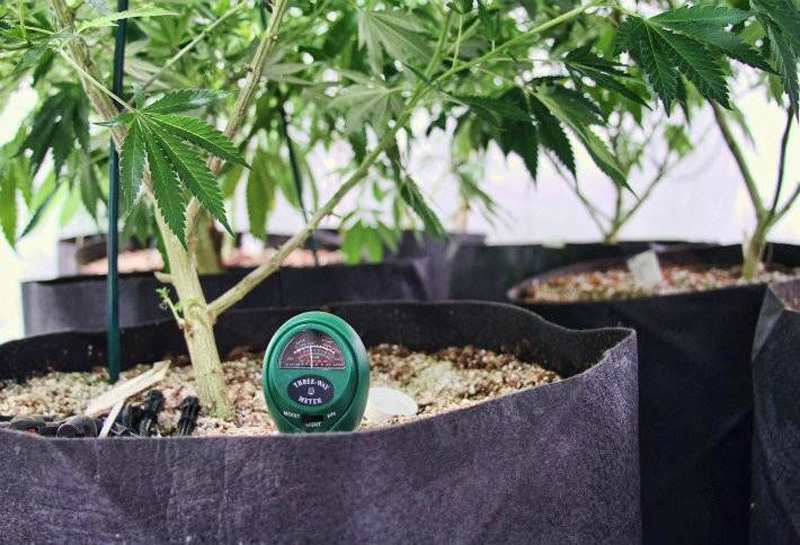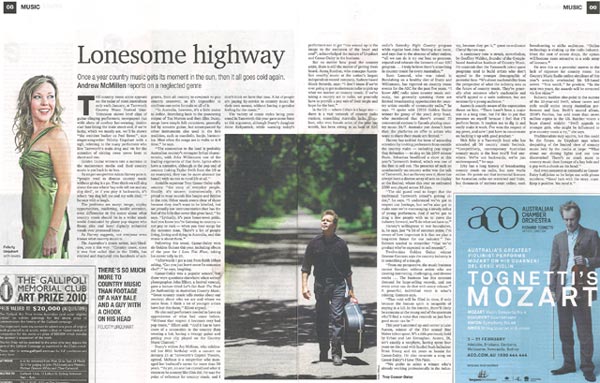This is by far the biggest story of my career; you can read about how it happened here. Full story text included below.
Lonesome Highway
Once a year country music gets its moment in the sun, then it all goes cold again. Andrew McMillen reports on a neglected genre
The country music scene appears on the radar of most Australians only each January, at Tamworth Country Music Festival time. Television shows brief clips of guitar-slinging performers; newspapers run wide shots of cowboy hat-wearing, denim-clad fans lining the main street and, if we’re lucky, which we mostly are, we’ll be shown “the weirdest busker on Peel Street”, says singer-songwriter Felicity Urquhart with a sigh, referring to the many performers who line Tamworth’s main drag and vie for the attention of visiting news crews keen to shoot and run.
Golden Guitar winners rate a mention in the mainstream media and then country music is put back in its box.
As singer-songwriter Adam Harvey puts it, “people tend to dismiss country music without giving it a go. They think we still sing about the one where ‘my wife left me and my dog died’, or if you play it backwards, it’s where ‘my dog left me and my wife died,’ ” he says with a laugh.
The problems are many: image, airplay opportunities, marketing, media attention, even differences in the sector about what country music should be in a wider music world dominated by glossy pop singers who flaunt skin and layer digitally enhanced vocals over processed beats .
As Harvey suggests, not everyone even knows what country music is.
The Australian’s music writer, Iain Shedden, puts it this way. “Country music, since it was first called that in the 1940s, has evolved and fractured into hundreds of sub-genres, from alt country to cowpunk to pop country crossover, so it’s impossible to attribute one strict formula to all of it.
“In Australia, however, it’s a little easier to define. Stretching back to the pioneering output of Tex Morton and then Slim Dusty, songs have simple folk structures, generally led by acoustic guitar, but accompanied by other instruments also used in the folk tradition, such as mandolin, banjo, harmonica. Most often the songs are in waltz or 4/4 time,” he says.
“The connection to the land is probably Australian country’s strongest lyrical characteristic, with John Williamson one of the leading exponents of that form. Lyrics often have a narrative, although at the pop end of country (taking Taylor Swift from the US as an example), they can be more abstract (or banal) with no ties to rural life at all.”
Amiable superstar Troy Cassar-Daley calls country “the story of everyday people. Vocally, it’s sincere; instrumentally, it’s proud to wear sounds like banjos and fiddles in the mix. Other music steers clear of those because they don’t want to be labelled, but we proudly use instrumentation that has the feel of the hills that cover this great land,” he says. “Lyrically, it’s pure home-town pride. And you know you’re listening to country – not pop or rock – when you hear songs for the common man. There’s a lot of people living, loving and dying in Australia, and this music is about them.”
Following this creed, Cassar-Daley won six Golden Guitars this year, including album of the year for I Love This Place, taking his career tally to 20.
“Afterwards I got a text from Keith Urban asking, ‘Can you just leave some for someone else?’,” he says, laughing.
Cassar-Daley was a popular winner, but there were questions elsewhere when writer-photographer John Elliott, a festival veteran, gave a lecture titled Let’s Get Real: The Need for Authenticity in Australian Country Music. “Great country music tells stories about our country; about who we are and where we come from. I think a lot of younger artists have lost this focus,” Elliott argued.
He also said performers needed to have an appreciation of what had come before. “Without that respect it becomes very bad pop music,” Elliott said. “And it has to have more of a connection to the country than wearing a hat, having a twangy guitar and getting your clip played on the Country Music Channel.”
Dusty’s widow Joy McKean, who celebrated her 80th birthday with a concert on January 21 at Tamworth’s Capitol Theatre, agreed. McKean is a songwriter who managed her husband’s career for more than 50 years. “As yet, no one has crystallised what it means to be country like Slim did. He was the point of reference for country music, and I don’t think we have that now. A lot of people are paying lip-service to country music for their own means, without having a genuine feeling for the music.”
The variety of music styles being presented in Tamworth this year gave some force to this argument, although Dusty’s daughter Anne Kirkpatrick, while warning today’s performers not to get “too wound up in the image to the exclusion of the heart and soul”, acknowledged the stature of Urquhart and Cassar-Daley in the business.
But no matter how good the country artist, there is still the matter of getting them heard. Aneta Butcher, who manages Australian country music at the nation’s largest independent record company, Sydney-based Shock Records, says: “I don’t know if we’re ever going to get mainstream radio to pick up what we market as country music. If we’re taking a country act to radio, we generally have to provide a pop mix of their single and hope for the best.”
In the US – where Urban is a huge star – there is a vast network of country radio stations, something Australia lacks. Urquhart, who won female artist of the year last month, has been sitting in as host of ABC radio’s Saturday Night Country program while regular host John Nutting is on leave, and says that in the absence of other outlets, “all we can do is try our best to promote, expand and educate the listeners of our ABC program … I truly believe there’s something in country music for every Australian.”
Scott Lamond, who was raised in Bundaberg on a healthy diet of Dusty and Williamson, has reported on country music events for the ABC for the past five years. “I know ABC radio takes country music seriously, but generally speaking there are limited broadcasting opportunities for country artists outside of community radio,” he says. “I spoke with [2010 Golden Guitar winner for group of the year] Jetty Road, who mentioned that there’s around 70 commercial stations in Canada playing country music 24/7. Australia just doesn’t have that; the platforms on offer to artists who want to share their music are limited.”
Harvey has tackled the issue of attracting attention by inviting performers from outside the country realm – including pop singer Guy Sebastian – to sing on his 2009 release Duets. Sebastian headlined a show at this year’s Tamworth festival, which was one of the first to sell out. The presence of such an unashamedly un-country artist was the talk of Tamworth, but as Harvey sees it, there has always been a diverse array of acts on display at the festival, where this year an estimated 2500 acts played across 10 days.
“The old guard tend to forget that the traditional Tamworth crowd’s getting older,” he says. “I understand we’ve got to respect our heritage, but we’ve also got to make sure we’re encouraging a steady influx of young performers. And if we’ve got to drag a few people with us to move the industry forward, we’ll do what we have to.”
Harvey’s willingness to test boundaries, is, he says, just “a bit of common sense. I’m aware of how important it is that we plan a long-term future for our industry.” Performers needed to remember “that we’re product who’re expected to sell records”.
Twelve-time Golden Guitar winner Graeme Connors says the country industry is in something of a trough.
“From my perspective, the music business cannot function without artists who are creating interesting, challenging, and diverse works … The business has this constant demand for large-selling records, and not every artist can do that with every release.” A powerful, individual voice is what’s missing, Connors says.
“That void will be filled in time, if only because the human spirit is incapable of staying in a lull. In the interim, there’ll likely be someone at the young end of the spectrum who’ll find a voice that reminds us just how good music can be.”
This year’s anointed up-and-comer is Luke Austen, winner of the 31st annual Star Maker talent quest. It’s a title previously held by Urban and Lee Kernaghan. Austen, 28, isn’t exactly a neophyte, having spent four years on the road with lauded bush balladeer Brian Young and six years as bassist for Cassar-Daley. He also co-wrote a song on Cassar-Daley’s I Love This Place.
“We prefer to select a winner who’s already working professionally in the industry, because they get it,” quest co-ordinator Cheryl Byrnes says.
A cautionary note is struck, nevertheless, by Geoffrey Walden, founder of the Gympie-based Australian Institute of Country Music. He contends that the Tamworth talent quest programs tend to build artists who don’t appeal to the younger demographic of potential fans. “It’s about marketability from the perspective of what the industry sees as the future of country music. They’re generally after someone who’s marketable and who’ll appeal to a wide audience, but not necessarily a young audience.”
Austen is acutely aware of the expectation thrust on him. “There hasn’t been a major star in a long time, but I’d like to put that pressure on myself because I feel that I’ll perform better. It inspires me to dig in and really make it work. I’ve won the respect of my peers, and now I just have to concentrate on backing it up with good product.”
Nick Erby is a Tamworth local who has attended all 38 country music festivals. “Competitively, contemporary Australian country music is the best you’ll find anywhere. We’re not backwards, we’re just underexposed,” he says.
Erby has a long history of broadcasting country music on radio, but now works online. He points out that terrestrial licenses for Australian radio are restricted and finite, but thousands of stations exist online, each broadcasting to niche audiences. “Online technology is shaking up the radio industry. Once the cost of access drops, the option will become more attractive to a wide array of listeners.”
He sees this as a potential answer to the lack of exposure for country music: his Country Music Radio online simulcast of this year’s awards overloaded his US-based server. “You watch,” he predicts. “In the next two years, the awards will be streamed via live video.”
Industry insiders also point to the success of the 20-year-old Swift, whose career and style could entice young Australian performers and fans. Swift’s second album, 2008’s Fearless, has sold more than seven million copies in the US. Butcher voices a hope shared widely: “Swift appeals to younger girls, who might be influenced to give country music a try,” she says.
Traditionalists may squirm, but this could be the future. As Urquhart says when despairing of the limited view of country music held by the media at large: “What about our shining lights and our new discoveries? There’s so much more to country music than footage of a hay bale and a guy with a chook on his head.”
And even someone as successful as Cassar-Daley half-jokes as he helps out with phone numbers: “Good luck with the story, mate. Keep it positive. We need it.”

